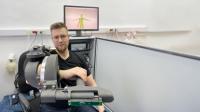The exoskeleton will aid in hand therapy
Effective therapy at home, without the need for constant care from a physiotherapist? This could become a reality thanks to a project by the team from the Warsaw University of Technology and Łukasiewicz PIAP– Institute of Industrial Automation and Measurements.
The exoskeleton was created for individuals who, due to an accident or illness, cannot move their upper limb at all, or their range of motion has been significantly limited.
– The device consists of printed parts connected with motorized rotary pairs or free sliding bearings – says Piotr Falkowski, a doctoral student at the Warsaw University of Technology and the project leader.
The structure is worn over the entire upper limb. It supports the movements of the shoulder and elbow joint through proper control of the electric drives.
The solution will not replace professional physiotherapist assistance but will facilitate their work.
– The specialist will not need to personally and continuously supervise each patient but will instead demonstrate the exercise - showing the correct movement by moving a limb with the exoskeleton attached – explains Piotr Falkowski. – Then, the device will assist the patient in independent exercises, observing and correcting their mistakes - including anatomical and structural errors.
This model will enable exercises to be performed at home, eliminating the need for trips to rehabilitation centers, which is an additional challenge for individuals recovering from injuries, battling illnesses, or having mobility issues. Moreover, it also offers a chance to reduce the wait for specialist help and therapy, as well as a fundamental change in the way physiotherapists work. It is possible that one person could remotely manage more devices at the same time, thereby helping a larger number of patients.
The prototype of the exoskeleton is ready – it weighs 8.4 kg and was printed in 3D. However, the final solution must be lighter and possibly even more durable. Therefore, work needs to be done to find the optimal material. Plans also include the development of functionalities – the exoskeleton will utilize virtual reality for visualization. This will serve as encouragement and motivation for patients to exercise. Monotony is another reason why the rehabilitation process can be ineffective or take longer than anticipated.
This solution is a project of the team from the Warsaw University of Technology and Łukasiewicz PIAP – Institute of Industrial Automation and Measurements. The first version of the device was developed by Piotr Falkowski (leader), Bazyli Leczkowski, Julia Wilk, Wojciech Kiński, and Zbigniew Pilat, PhD.
The rehabilitation exoskeleton was awarded in the 14th edition of the National Student-Inventor Competition, which has been organized by the Świętokrzyski University of Technology since 2010. This year, 123 solutions were submitted by 247 creators from 21 universities across Poland. Five main prizes were awarded, one of which was received by the project from WUT and PIAP. The awarded projects will be presented and promoted during the International Exhibition of Inventions in Geneva.









